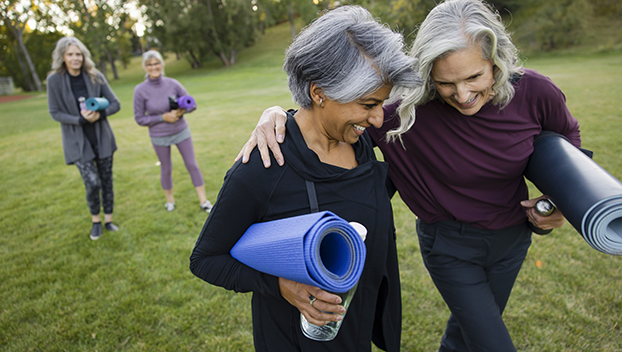HEALTHY LIVING — Meeting your fitness goals in the winter
Published 12:14 am Sunday, January 28, 2024

- When living with a chronic condition, regular exercise can help you manage symptoms and improve your health. Aerobic exercise can help to improve your heart health and endurance and aid in weight loss.
|
Getting your Trinity Audio player ready...
|
BRRRRR, here we are smack dab in the middle of winter. All you want to do is hibernate in your nice warm home, snuggled under a blanket with a hot beverage.
Getting regular exercise during the cold winter months can be difficult, especially if you hate jogging on the treadmill or power walking through the grocery store.
Cold rain, wind and plunging temperatures can discourage even the most motivated person from exercising, but it doesn’t have to be that way.
Trending
Exercising during the winter is important because it will make you feel more energetic, which should make it easier for you to get out of bed on those cold, dark mornings. If you’re the type of person who is affected by shorter daylight hours, keeping active can improve your sense of well-being … and help you avoid the desire to eat more during the winter months.
If you’re tempted to stash away your workout gear and hibernate for the winter, here are some ways to combat the cold:
Layer Up! Many people make the mistake of dressing too warmly during a winter workout. When you exercise, you produce a considerable amount of body heat that makes the weather feel warmer than it actually is.
However, the problem starts when your sweat dries and you start to get chilled.
What is the solution?
Dress in layers! You can add and remove clothing as necessary. Avoid making cotton your first layer since it absorbs moisture and stays wet near your skin.
Trending
Instead, wear a thin layer of synthetic material that is designed to wick sweat away from your body. Then, add a layer of fleece for extra warmth and top that with a breathable, waterproof outer layer. Resist the temptation to pack on a heavy jacket or vest because it may cause you to overheat, especially if you’re engaging in an aerobic workout.
If it’s particularly cold, you can wear a face mask or scarf to heat the air before it enters your body. Of course, it’s always best to experiment with a wide variety of clothing that suits your level of exercise intensity.
Remember that stop-and-go activities, such as alternating walking and jogging, can make you more susceptible to the cold weather if you start to sweat and then cool off.
Cover your extremities! Your hands, feet and ears are most vulnerable. In cold weather, the blood flow is typically concentrated in the middle of your body, which leaves less for your extremities.
To protect your hands, try wearing two layers of gloves — a thin layer underneath a heavy layer — so that you can remove the top layer if your hands start to sweat. For your feet, consider purchasing sneakers that are a little big so that you can wear thick thermal socks.
Your ears are also important, so don’t forget to bring a hat or a headband.
Watch the weather! Working out in a cold rain can make you even more vulnerable to hypothermia. If your clothes get wet, your body temperature may fall, although you’re wearing multiple layers wind is also a problem.
Even if you dress warmly and wear multiple layers, wind can make outdoor workouts unsafe because the wind can penetrate your clothes and remove any warm air that surrounds your body.
A good rule of thumb is to choose an indoor activity if the temperature dips below 38 degrees Fahrenheit. If it’s particularly windy outside, do the second half of your workout with the wind at your back. That way, you’re at less risk for getting chilled after you’ve worked up a sweat.
If it’s exceptionally cold and raining, do your workout indoors and skip the outdoors completely until the weather improves.
Hydration is not just for the summer! You can become just as dehydrated in the cold weather as in the hot weather, but it may be harder to notice. Sweating, urinating, and breathing all release water from your body, so be sure to drink lots of fluids before, during, and after your workout.
Fueling your workout is a little more complicated. You need to consume an adequate amount of food in order to have enough energy to exercise, and this fact is amplified during the winter when you also have to generate enough body heat to keep yourself warm.
The good news is that the digestion process does much of the work for you since it creates heat in the process of distributing energy throughout your body. The key to fueling your winter workout is to consume nutrients that are digested quickly and easily, but provide enough energy for long efforts. Carbohydrates like oatmeal, bananas, pasta and peanut butter on whole-wheat toast are great ways to warm up and fuel up for working out in the cold!
Just because it’s cold outside doesn’t mean that you should stop exercising. With a little extra preparation, your winter workout can be fun, safe, and satisfying.
Stay warm and healthy, my friends.
Jody Holton writes about health for Port Arthur Newsmedia. She can be reached at jholton3@gt.rr.com.






